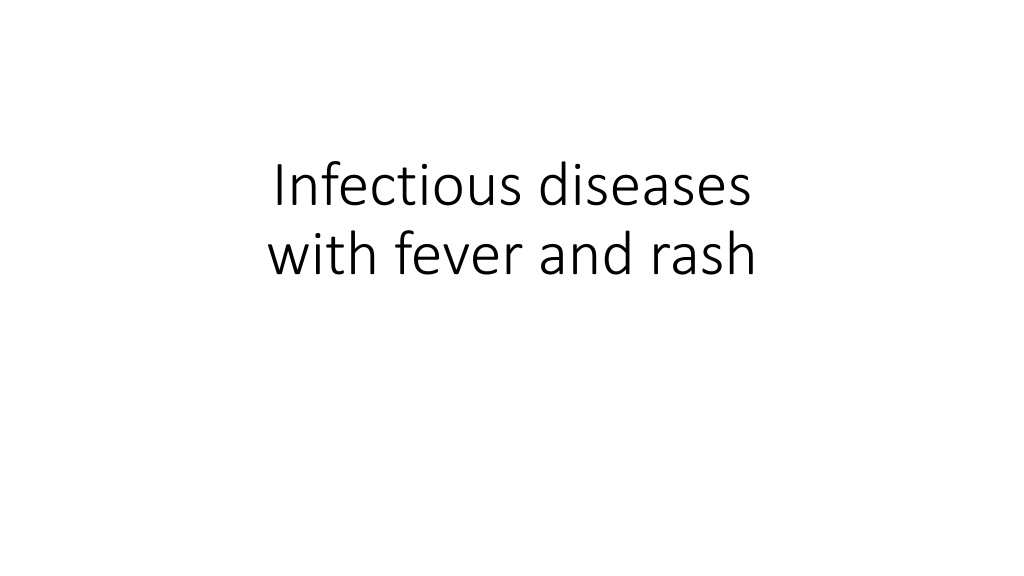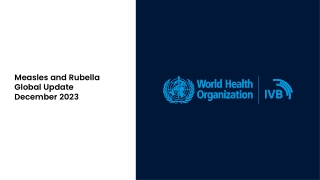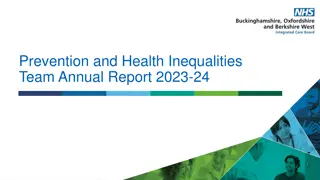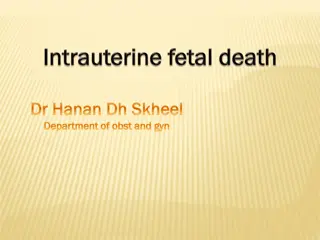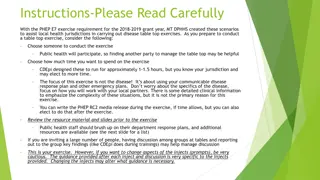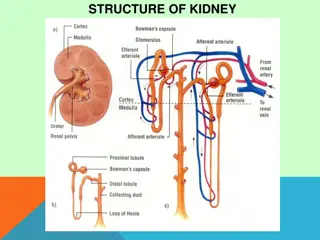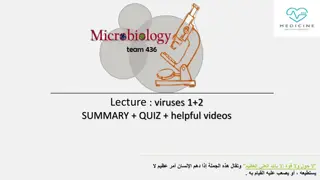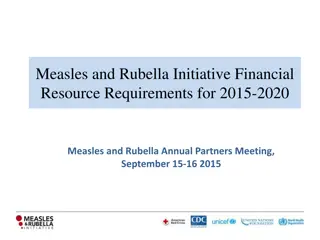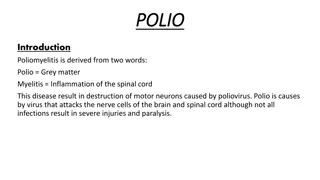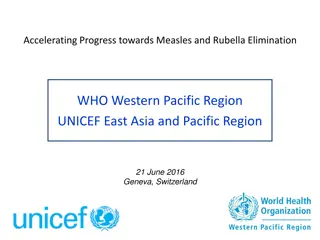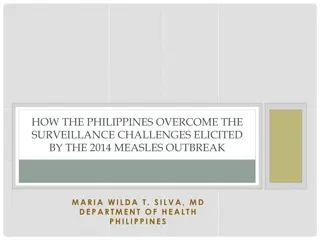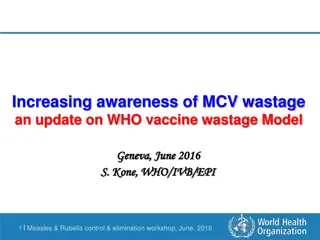Measles: Causes, Symptoms, and Prevention
Measles, caused by a contagious RNA virus, presents with fever, rash, and other distinctive symptoms. Learn about its epidemiology, signs, and treatment to prevent its spread.
Download Presentation

Please find below an Image/Link to download the presentation.
The content on the website is provided AS IS for your information and personal use only. It may not be sold, licensed, or shared on other websites without obtaining consent from the author.If you encounter any issues during the download, it is possible that the publisher has removed the file from their server.
You are allowed to download the files provided on this website for personal or commercial use, subject to the condition that they are used lawfully. All files are the property of their respective owners.
The content on the website is provided AS IS for your information and personal use only. It may not be sold, licensed, or shared on other websites without obtaining consent from the author.
E N D
Presentation Transcript
Infectious diseases with fever and rash
MEASLES -ETIOLOGY Measles (rubeola) is highly contagious and is caused by a single- stranded RNA paramyxovirus Humans are the only natural host.
MEASLES -EPIDEMIOLOGY Health due about Measles virus is transmitted by droplets or the airborne route and is highly contagious. Infected persons are contagious from 1 to 2 days before onset of symptoms from about 5 days before to 4 days after the appearance of rash Immunocompromised persons can have prolonged excretion of contagious virus. practitioners the the MMR need in to be following aware of measles to rise cases public anxiety vaccination
MEASLES -EPIDEMIOLOGY Measles remains endemic in regions of the world where measles vaccination is not available and is responsible for about 1million deaths annually.
MEASLES - SIGNS AND SYMPTOMS Measles infection is divided into four phases: incubation, prodromal (catarrhal), exanthematous (rash), and recovery. The incubation period is 8 to 12 days from exposure to symptom onset. The manifestations of the 3-day prodromal period are cough, coryza, conjunctivitis, and the pathognomonic Koplik spots (gray-white, sand grain- sized dots on the buccal mucosa opposite the lower molars) that last 12 to 24 hours. The conjunctiva may reveal a characteristic transverse line of inflammation along the eyelid margin (Stimson line). The classic symptoms of cough, coryza, and conjunctivitis often is accompanied by high fever (40 C-41 C)
MEASLES - SIGNS AND SYMPTOMS The macular rash begins on the head (ofen above the hairline) and spreads over most of the body in a cephalad to caudal pattern over 24 hours. Areas of the rash often are confluent. The rash fades in the same pattern, and illness severity is related to the extent of the rash. As the rash fades, it undergoes brownish discoloration and desquamation. Cervical lymphadenitis, splenomegaly, and mesenteric lymphadenopathy with abdominal pain may be noted with the rash. Otitis media, pneumonia, and diarrhea are more common in infants. Liver involvement is more common in adults.
MEASLES -LABORATORY AND IMAGING Routine laboratory fndings are nonspecifc and do not aid in diagnosis. Leukopenia is characteristic. In patients with acute encephalitis, the cerebrospinal fluid reveals an increased protein, a lymphocytic pleocytosis, and normal glucose levels.
MEASLES - TREATMENT Routine supportive care includes maintaining adequate hydration and antipyretics. High-dose vitamin A supplementation has been shown to improve the outcome of infants with measles in developing countries. The World Health Organization recommends routine administration of vitamin A for 2 days to all children with acute measles.
MEASLES - TREATMENT In developing countries, where malnutrition and vitamin A defciency lead to impaired cell-mediated immunity, measles often follows a protracted course with severe complications. Impaired cellular immune responses such as in HIV infection may result in a modifed or absent rash, with an increased risk of dissemination, includipro giant-cell pneumonia or encephalitis
MEASLES -COMPLICATIONS AND PROGNOSIS Otitis media is the most common complication of measles infection. Interstitial pneumonia can occur, or pneumonia may result from secondary bacterial infection. Persons with impaired cell-mediated immunity may develop giant cell (Hecht) pneumonia, which is usually fatal. Myocarditis and mesenteric lymphadenitis are infrequent complications.
MEASLES -COMPLICATIONS AND PROGNOSIS Encephalomyelitis occurs in 1 to 2 per 1000 cases and usually occurs 2 to 5 days afer the onset of the rash. Early encephalitis probably is caused by direct viral infection of brain tissue, whereas later onset encephalitis is a demyelinating and probably an immunopathologic phenomenon. Subacute sclerosing panencephalitis is a late neurologic complication of slow measles infection that is characterized by progressive behavioral and intellectual deterioration and eventual death. It occurs in approximately 1 in every 1 million cases of measles, an average of 8 to 10 years afer measles. There is no effective treatment.
MEASLES -COMPLICATIONS AND PROGNOSIS Deaths most frequently result from bronchopneumonia or encephalitis, with much higher risk in persons with malignancy, severe malnutrition, age under 5 years, or immunocompromise (such as HIV infection). Late deaths in adolescents and adults usually result from subacute sclerosing panencephalitis.
MEASLES - PREVENTION VACCINATION !!!
MUMPS -ETIOLOGY The mumps virus is RNA virus of the Rubulavirus genus and Paramyxovirus family.
MUMPS -EPIDEMIOLOGY Mumps occurs worldwide, but its incidence has declined because of the mumps component of the MMR Following the decrease in the uptake of the MMR immunisation in the late 1990s, there has been a rise in unimmunised children and young adults. Mumps usually occurs in the winter and spring months. It is spread by droplet infection to the respiratory tract where the virus replicates within epithelial cells. The virus gains access to further dissemination to other Infectivity is for up to 7 days swelling. dramatically vaccine. unvaccinated the parotid glands before tissues. after the onset of parotid
MUMPS -SIGNS AND SYMPTOMS The Onset but Only involvement usually The parotitis of earache or Examination swelling. The fever incubation of in up one period illness 30% may occurs uncomfortable pain on the parotid Occasionally, usually is 15 24 with cases, swollen over days. the to side is fever, the malaise infection initially, next children drinking. may may 3 4 parotitis, subclinical. bilateral days. may complain and is but of be the and few is eating or of duct swelling within show redness absent. and parotid disappears be days.
LABORATORY AND IMAGING Plasma associated pancreatic amylase with involvement levels abdominal are often pain, elevated may and, when of be evidence
TREATMENT Symptomatic
COMPLICATIONS AND PROGNOSIS The hearing and illness is generally can mild mumps, and selflimiting. is Although unilateral loss follow it usually transient. Viral meningitis and encephalitis - lymphocytes CSF in about 50%, in 10%, and encephalitis common clinical features vomiting and neck are seen only 5000. The in the meningeal signs are seen in about are 1 in headache, photophobia, stiffness.
COMPLICATIONS AND PROGNOSIS Orchitis is the uncommon it is Although sperm Rarely, most prepubertal unilateral. is some infertility mastitis feared complication, males. although does it is in When it occur, usually there count, oophoritis, evidence is actually and of a reduction in extremely arthritis unusual. occur. may
MUMPS - PREVENTION VACCINATION !!!
RUBELLA -ETIOLOGY Rubella, also known as German measles or 3-day measles, is caused by a RNA virus and is a member of the togavirus family. Humans are the only natural host. Rubella virus is most contagious through direct or droplet contact with nasopharyngeal secretions from 2 days before until 5 to 7 days afer rash onset, although virus may be present in nasopharyngeal secretions from 7 days before until 14 days afer the rash. Infection in utero results in signifcant morbidity from congenital rubella syndrome (CRS) with associated ophthalmologic, cardiac, and neurologic manifestations.
RUBELLA -EPIDEMIOLOGY In unvaccinated populations, rubella usually occurs in the spring, with epidemics occurring in cycles of every 6 to 9 years. Approximately 25% to 50% of cases are subclinical.
RUBELLA -SIGNS AND SYMPTOMS The incubation period for postnatal rubella is typically 16 to 18 days (range 14 to 21 days). The characteristic signs of rubella are posterior cervical and posterior occipital lymphadenopathy accompanied by an erythematous, maculopapular, discrete rash. The rash begins on the face and spreads to the body, lasting for 3 days and less prominent than that of measles.
RUBELLA -SIGNS AND SYMPTOMS Rose-colored spots on the soft palate, known as Forchheimer spots, develop in 20% of patients and may appear before the rash. Other manifestations of rubella include mild pharyngitis, conjunctivitis, anorexia, headache, malaise, and low-grade fever. Polyarthritis, usually of the hands, may occur, especially among adult females, but usually resolves without sequelae. Paresthesias and tendinitis may occur.
RUBELLA - LABORATORY AND IMAGING Routine laboratory fndings are nonspecifc and generally do not aid in diagnosis. The white blood cell count usually is normal or low, and thrombocytopenia rarely occurs. Diagnosis is confrmed by serologic testing for IgM antibodies (typically positive 5 days afer symptom onset).
RUBELLA -TREATMENT There is no specific therapy for rubella. Routine supportive care includes maintaining adequate hydration and antipyretics.
RUBELLA - COMPLICATIONS AND PROGNOSIS Congenital rubella syndrome Others complications are rare. Deaths rarely occur with rubella encephalitis.
RUBELLA - PREVENTION VACCINATION !!!
MMR MMR for children at 12 to 15 months and at 4 to 10 years of age. Afer vaccination, rubella virus is shed from the nasopharynx for several weeks, but it is not communicable. In children, rubella vaccine rarely is associated with adverse effects, but in postpubertal females, it causes arthralgias in 25% of vaccinated individuals and acute arthritis-like symptoms in 10% of vaccinated individuals. These symptoms typically develop 1 to 3 weeks afer vaccination and last 1 to 3 days.
MMR Contraindications to MMR vaccine include immunocompromised states or an immunosuppressive course of corticosteroids (>2 mg/kg/day for >14 days). Vaccine virus has been recovered from fetal tissues, although no cases of CRS have been identifed among infants born to women inadvertently vaccinated against rubella during pregnancy. Nevertheless women are cautioned to avoid pregnancy after receipt of rubella-containing vaccine for 28 days. All pregnant women should have prenatal serologic testing to determine their immune status to rubella, and susceptible mothers should be vaccinated after delivery and before hospital discharge. Susceptible, nonpregnant persons exposed to rubella should receive rubella vaccination.
ROSEOLA INFANTUM -ETIOLOGY Roseola infantum (exanthem subitum, sixth disease) is caused primarily by human herpesvirus type 6 (HHV-6), and by HHV-7 in 10% to 30% of cases. HHV-6 and HHV-7 are DNA viruses that are members of the herpesvirus family.
ROSEOLA INFANTUM -EPIDEMIOLOGY Transplacental antibody protects most infants until 6 months of age. The incidence of infection increases as maternally derived antibody levels decline. HHV-6 is a major cause of acute febrile illnesses in infants and may be responsible for 20% of visits to the emergency department for children 6 to 18 months of age.
ROSEOLA INFANTUM -SIGNS AND SYMPTOMS Roseola is characterized by high fever (ofen >40 C) with an abrupt onset that lasts 3 to 5 days. A maculopapular, rose-colored rash erupts when the fever is finished. The rash usually lasts 1 to 3 days but may fade rapidly and is not present in all infants with HHV-6 infection.
ROSEOLA INFANTUM -SIGNS AND SYMPTOMS Upper respiratory symptoms, nasal congestion, erythematous tympanic membranes, and cough may occur. Most children with roseola are irritable and appear toxic. Roseola is associated with approximately one third of febrile seizures. Reactivation of HHV-6 following bone marrow transplantation may result in bone marrow suppression, hepatitis, rash,and encephalitis.
ROSEOLA INFANTUM - LABORATORY Routine laboratory fndings are nonspecifc and do not aid in diagnosis.
ROSEOLA INFANTUM -TREATMENT There is no specifc therapy for roseola - routine supportive care includes maintaining adequate hydration and antipyretics. In immunocompromised hosts, use of ganciclovir or foscarnet can be considered.
